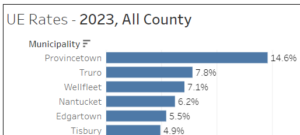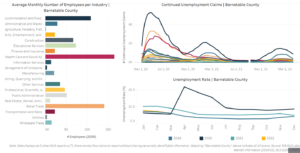Cape Cod: The Struggles of Year-Round Residents
Barnstable County contains all 15 Cape Cod municipalities. In 2023, the unemployment rate there was 4.7 percent, while the state average was 2.6 percent. All but one municipality on the Cape had an unemployment rate above the state average. Provincetown, the northern tip of the Cape, faces the highest unemployment rate in the state at 14.6 percent. What causes Cape Cod’s unemployment rate to be so far above that of the state as a whole? Warm weather might be the answer.
For both Massachusetts residents and out-of-state vacationers, Cape Cod serves as a convenient oasis during the summer months. What many vacationers fail to realize is that those booming businesses look quite different during Massachusetts winters. The estimated year-round population of the Cape was 229,000 in 2022, but it’s argued that approximately 500,000 people reside on the Cape in the summer. The benefit is that a lot of business arrives Memorial Day; the downside is that a lot of it leaves in the fall.
The pandemic revealed just how fragile the Cape’s economy was. As industries were shutting down statewide, the hospitality, food service, and retail industries were among the hardest hit. These three industries employ almost half of the Cape’s labor force, and they also lack a steady flow of customers in the winter months. Many Cape businesses are forced to downsize their staff during the off season, and some even close temporarily. This has a huge impact on the labor force, as many employees lose their jobs during the off season, causing the unemployment rate to skyrocket.
Similar trends are observed on the islands of Nantucket and Martha’s Vineyard. Like Cape Cod, both are popular summer destinations with fewer year-round residents. Using Pioneer Institute’s LaborAnalytics, in 2023, the six municipalities with the highest unemployment rates were located on either Cape Cod or the islands.

Figure 1: Pioneer Institute’s LaborAnalytics website (2023)
According to the Bureau of Labor statistics, “summertime unemployment rates in all three area counties [are] lower than that of the nation,” but the winter time rates are significantly higher. The employment trends on the Cape and Islands indicate that those working in service industries make a large portion of their income during the roughly three months of their busy season. The figure below represents the volatile economic conditions in these summer destinations, and how it was exacerbated during the pandemic.

Figure 2: Cape Cod Commission
The uncertain unemployment issues pose another hardship for Cape Cod residents. The median home price for Barnstable County was $730,000 in 2023, and the median income in 2021, just a couple years prior, was $82,619 – significantly below what is necessary to afford the high house prices. With an uncertain economy, a lack of professional opportunities, and the inability for the average household to continue to afford living down the Cape, we may start to see a trend of people moving back across the bridge and away from their beach town sanctuaries.
Dana DiChiro is a Roger Perry Government Transparency Intern at the Pioneer Institute for Summer 2024. She is a rising senior studying Government & Politics and Economics at the University of Maryland, College Park.



